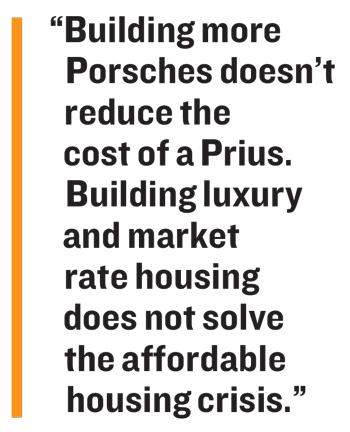At first, the most recent “state of the city” address from Beverly Hills Mayor John Mirisch was another slice of genteel life in the glamorous town.
Mirisch, 56, wearing a Los Angeles Dodgers tie, thanked Ringo Starr for “a peace and love star” he presented to the city and apologized “if my throat is hoarse” from a city sing-along event the previous night. “Arts and culture are so important to any community,” Mirisch stated, before making his pivot: “Especially in this age of polarized politics.”
The mayor then proceeded to detail his grand political and economic vision, a blend of socialism and the concept of self-governing communities. What unifying threads Mirisch advocated for were perhaps threefold: that single-family housing — and single-family-zoned properties — are good, that state government making local real estate decisions is bad, and that private developers being called upon to solve a statewide affordable housing crisis is really bad.
Mirisch’s thinking is rooted in growing up in Beverly Hills (he is the grandson of famed movie producer Harold Mirisch). It also stems from spending much of his adult life overseas in Sweden, where he initially relocated to work in film distribution.
Today, Beverly Hills has some of the toughest rent stabilization laws in Los Angeles, requiring landlords to pay relocation fees even for “just cause” evictions. Only about 41 percent of homes there are owner-occupied, and according to the Beverly Hills Renters Alliance, half of the rental residences are protected by the rent stabilization ordinance.
Mirisch has a statewide profile as a thorny and unique foe of California legislation in which local governments lose control of real estate decisions, such as Senate Bill 50, which would allow for higher-density residential developments near transit areas.
The mayor recently spoke with TRD at Beverly Hills City Hall about his role as housing-policy iconoclast.
You’re a Republican. But your housing policies seem almost socialist, at least as they relate to the state affordable housing shortage, where you say state and not private money should go toward building housing. How would you describe your politics as it relates to residential real estate? Although I’m registered as a Republican, some of my politics would be considered to the left of certain Democrats. I think a lot of the way I think, not just when it comes to policy, is colored by being a Swedish citizen, and having lived in Sweden, and looking at the quality of life in Sweden and how things work there.
 You have policies in place in Sweden so that not everyone in Sweden moves to Stockholm and Gothenburg. So that there are other places where people can choose to live that are wonderful places. Unfortunately, in California, there has been too much of a focus on trying to figure out how to accommodate even more people in the Los Angeles, San Francisco, and San Jose urban areas. Everywhere from Stockton, to Merced, to Bakersfield, to Barstow, to Visalia, there are a ton of cities that would like to have that kind of economic development. The state could do carrot-and-stick incentives to ensure economic development is spread out throughout the state.
You have policies in place in Sweden so that not everyone in Sweden moves to Stockholm and Gothenburg. So that there are other places where people can choose to live that are wonderful places. Unfortunately, in California, there has been too much of a focus on trying to figure out how to accommodate even more people in the Los Angeles, San Francisco, and San Jose urban areas. Everywhere from Stockton, to Merced, to Bakersfield, to Barstow, to Visalia, there are a ton of cities that would like to have that kind of economic development. The state could do carrot-and-stick incentives to ensure economic development is spread out throughout the state.
What are your biggest issues with state government? Well, RHNA is a total joke. [The Regional Housing Needs Assessment is a state requirement that municipalities have 10-year housing plans.] You look at the figure of 1.3 million units [the number of affordable housing units Southern California is short in having, according to the state] — it’s a purely punitive figure. It’s punitive and political, and it’s not rational.
Well, if you increase the housing supply, logically, wouldn’t that drive the demand and cost for housing down? No. I put it this way. Building more Porsches doesn’t reduce the cost of a Prius. Building luxury and market rate housing does not solve the affordable housing crisis.
Commercial development is a vicious circle. The more you have commercial development, the more that creates an increased need for housing. Look at what Culver City is doing. Amazon and Google are coming in there. They’re adding 7,000 jobs. When those jobs are created, I think at a certain point, communities should have a plan for housing the people who are filling those jobs.
Regarding your views on housing — do you have kindred spirits on this subject with other local mayors? Well, it’s city by city. I think Culver City is maybe an outlier, because they seem to buy the YIMBY [“Yes, In My Backyard”] narrative that growth is unlimited. That the only limits to growth are ingenuity, creativity, that sort of thing.
It’s a narrative which, by the way, is completely in lockstep with what the Trump administration is pushing. In fact, HUD Secretary Ben Carson has said the reason prices are so expensive in Southern California is because there are too many single-family houses. Trump is a developer president. He wants there to be as few regulations as possible so he can build as much as possible.
There is a shortage of affordable housing in Southern California, whatever the exact figures are, plus about 58,000 homeless in Los Angeles County. If unfettered housing construction is not a first step to address the problem, what is? I think there’s the tendency, because people sometimes have agendas, to say this is a housing crisis, to downplay the element that is part of the larger opioid crisis that we have throughout the country. When I go to the U.S. Conference of Mayors, or National League of Cities, and see that this is a problem from West Virginia, to the old rust belt, all over the country. There’s a lot of downplaying of the mental illness and opioid crisis when it comes to our homeless as well.
The city of Los Angeles is considering whether to make affordable housing units a requirement of any multifamily development. What’s your thought on that policy? We actually adopted in December an inclusionary zoning ordinance that was too little for my liking. It was only at 10 percent [meaning at least 10 percent of all units in multifamily properties must qualify as affordable]. I think 20 is even better, the way that our neighboring city of West Hollywood has. You can look at Santa Monica, and they have 30. But the council wasn’t comfortable with that.
What do you like about single-family housing? Single-family housing is a choice. We should be offering with the county and urban area a wide variety of lifestyle choices, everything from single-family houses to multifamily to Manhattan-style living. The state shouldn’t limit that choice and impose one-size-fits-all solutions.
—This interview was edited and condensed for clarity.
